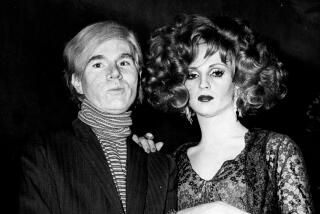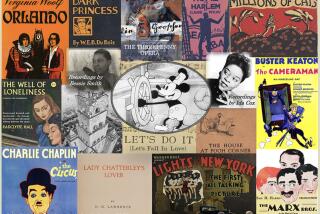Behind the scenes: How the ‘Queens of Animation’ transformed Disney
“Princesses were mostly absent from my childhood,” writes Nathalia Holt in “The Queens of Animation,” a new book about Disney’s early female artists. “Until I began writing this book, I viewed the Disney princesses, with their fluffy dresses and vulnerable demeanors, warily, suspicious that they had been dropped into my life by unknown misogynistic forces that were bent on turning my daughters into boy-crazy women.”
In researching the book, Holt says she found misogyny, both within the Disney studio and beyond, but also an inspiring sisterhood of female artists whose work left an indelible influence on the great animated features of the mid-20th century and beyond.
They were an extraordinary group. The author of “Rise of the Rocket Girls,” Holt profiles Bianca Majolie, Grace Huntington, Sylvia Holland, Retta Scott, Mary Blair and other pioneering artists in “The Queens of Animation.”
Readers meet Majolie, who had gone to high school with Walt Disney and joined the company in 1934, just as Disney was preparing to create “Snow White and the Seven Dwarfs.” She’d studied at the Chicago Academy of Fine Arts and sought work in fashion illustration before settling for sketching catalog copy for J.C. Penney.
It was on the strength of her side project, a comic strip about a Depression-era working woman, that Disney hired Majolie to work in the story department — the previously all-male group that created the narrative of all Disney productions.
Majolie recounts that the story department was filled with men who didn’t try to hide their disdain for their first female colleague, whom they treated to pranks and catcalls, “looking for any weakness they could find.” In the scene that opens Holt’s vividly written account, Majolie sees her drawings torn in half by Disney himself before a group of colleagues chase her down the corridor to her office. Majolie’s work on a popular short called “Elmer Elephant” would later serve her well in crafting the young lead of “Dumbo.”
Huntington, whose love for art was matched by her passion for airplanes, was the second woman hired as a writer in the story department. After working on “Snow White,” she left the company to pursue her dreams as an independent test pilot, setting altitude records on harrowing solo flights, but died just before the industry opened jobs to women.
Holland, who came to Disney as a young widowed mother of two, became known for her tender drawings of love and loss. Scott’s talent at capturing the natural world left audiences gasping at her terrifying dogs in “Bambi,” which debuted in 1942.
And Blair, who became a favorite of Disney’s, was a brilliant artist whose work ranged through decades of the studio’s projects. She played a key role in designing Disneyland’s “It’s a Small World” ride, which opened in 1966.
In a workplace that churned out fantasies of young female adventure and even (within the context of the times) empowerment, women workers were mostly consigned to the Ink and Paint department, staffed almost entirely by those under 25.
When the women Holt profiles managed to break into higher-level jobs, they said they still faced closed doors and limited opportunities. The author says the Burbank studio where they worked during the late 30s and early 40s era had an all-male sanctuary on the top floor, known as the Penthouse Club, where the company’s male artists could enjoy a bar, barbershop and steam room — no women allowed.
The artists’ struggles to be seen, heard and respected will resonate with anyone who has faced a hostile work or school environment. But not all of the book’s drama comes from gender politics.
Indeed, Holt examines multiple histories running alongside the story of women at Disney, especially how World War II both opened up opportunities for women in the workplace and sparked what would become the civil rights movement (early leaders objected to Disney’s whitewashed version of plantation life in 1946’s “Song of the South”).
Among the most radical changes she chronicles are those in technology — the inventions and advances that both furthered Disney’s animation and at times threatened it. As hand-drawn animation became too time-consuming and expensive, the studio turned to live-action films in the 60s and 70s; technological advances brought a resurgence, starting with 1989’s “The Little Mermaid,” while effectively killing off the once all-female Ink and Paint department.
A new era of animated movies, many starring princesses, followed. And Holt chronicles how the culture began changing. By 2013’s “Frozen,” the film’s co-directors organized what they called a “sister summit, in which female staff from all departments came together to talk about their lives as women and sisters. Men were allowed to attend but not speak.
And some of the stories just come full circle, as in the case of the animal observations at the heart of the original “Bambi” film. Holt writes, “at the studio, the sweet smell of hay filled an entire soundstage, where two young orphaned fawns, shipped by train all the way from Maine to Hollywood, nestled on the ground. The deer, named Bambi and Faline, slept while more than a dozen artists sat around on folding chairs and benches, sketching them.”
The scene was echoed decades later, when the animators on “Frozen” gathered around a live reindeer model for their sketches of its cinematic version, Sven. While working on “Bambi,” Holt notes, “only one woman, Retta Scott, sat in the circle drawing the deer. Now a dozen female animators were working on the film.”
Nathalia Holt
Little, Brown: 401 pages; $29
Tuttle is a book critic whose work also has appeared in the Boston Globe, the New York Times and the Washington Post.
More to Read
Sign up for our Book Club newsletter
Get the latest news, events and more from the Los Angeles Times Book Club, and help us get L.A. reading and talking.
You may occasionally receive promotional content from the Los Angeles Times.






